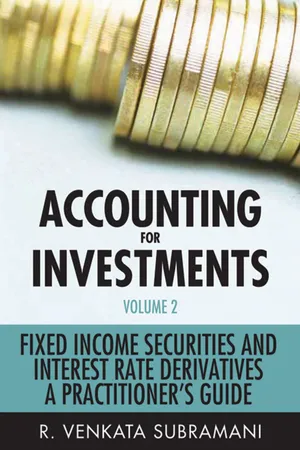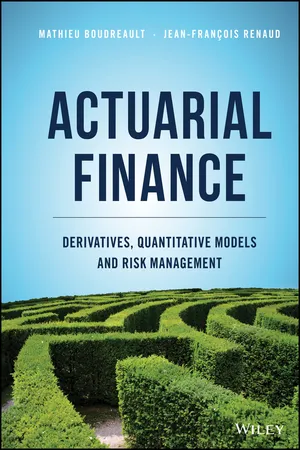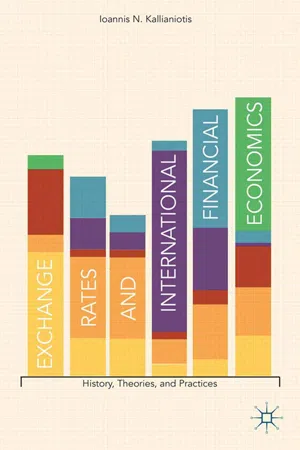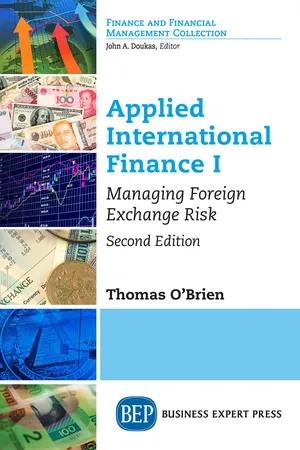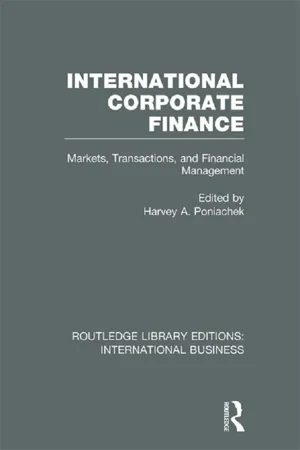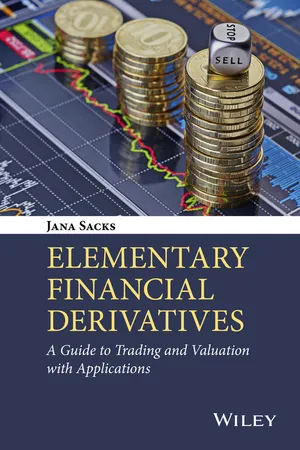Business
Cross Currency Swap
A cross currency swap is a financial agreement between two parties to exchange interest and principal payments in different currencies. This allows each party to access a desired currency without having to engage in foreign exchange transactions. Cross currency swaps are commonly used by businesses to manage currency risk and to secure more favorable borrowing terms in different markets.
Written by Perlego with AI-assistance
Related key terms
Related key terms
1 of 4
Related key terms
1 of 3
9 Key excerpts on "Cross Currency Swap"
- eBook - ePub
Accounting for Investments, Volume 2
A Practitioner's Handbook
- R. Venkata Subramani(Author)
- 2011(Publication Date)
- Wiley(Publisher)
A cross-currency swap is a foreign-exchange contract between two parties to exchange principal and/or interest payments of a loan in one currency for an equivalent loan in another currency. A cross-currency basis swap is an exchange of a fixed or floating rate note in one currency for a fixed or floating rate note in another currency. It may involve swapping payments in one currency for payments in another. At maturity the notional principal may also be swapped.Features of cross-currency swapThe tenure of a cross-currency swap typically ranges from one to fifteen years. Cross-currency swaps are suitable for entities that have loan commitments denominated in one currency, while the revenues generated by the entity are denominated in a different currency, resulting in a currency mismatch between the currency of the loan and the currency of the revenues. Cross-currency swaps are available in different currency pairs. Effectively, a cross-currency swap serves as an excellent hedging strategy for hedgers who wish to protect against both the currency rates as well as interest rate risks.Benefits of a cross-currency swap- A Cross-currency interest rate swap allow an entity to switch its loan from one currency to another.
- A Cross-currency interest rate swap enable an entity to manage foreign currency exposures. With a cross-currency swap the entity can use money it receives in one currency to pay off its loans in another currencycross-currency.
- The entity can focus on raising debt in the domestic market where it has its own strengths and still be able to swap the domestic local currency debt with any foreign currency with a cross-currency swap, thus effectively procuring foreign currency funds at low costs.
- eBook - ePub
Islamic Capital Markets
Theory and Practice
- Noureddine Krichene(Author)
- 2012(Publication Date)
- Wiley(Publisher)
- Cross-currency swaps offer companies opportunities to reduce borrowing costs in both domestic and foreign markets. They are also a simple and effective solution to long-term currency hedging needs. Investors use cross-currency swaps to manage the currency risk in foreign investment portfolios and to create synthetic assets with a specific currency risk profile.
Corporations and financial institutions use currency swaps to manage the exchange and interest rate risks associated with foreign currency financing and investing. Currency swaps are also valuable as long-term hedges of foreign exchange risk and in many instances represent an attractive alternative to long-dated forward foreign exchange cover.Currency swaps can be used in a variety of situations. By using currency swaps companies can tap foreign capital markets for low cost financing. The ability to swap interest payments related to financing denominated in foreign currency allows domestic debt issuers to tap new markets, expand the investor base, and lower borrowing costs.Foreign debt issues by top-rated companies are well received by foreign investors seeking to diversify credit risks and can be quite cost-effective compared to domestic issues. Through cross-currency swaps, the debt is converted to the issuer’s domestic currency, eliminating currency risk while preserving the cost advantages achieved by issuing offshore.Companies operating foreign subsidiaries typically prefer to finance operations in local currency to eliminate currency risk. Although borrowing locally may sometimes be cost effective, the parent can often borrow more cheaply in its home market and base currency. Currency swaps provide the bridge to exchange-protected least cost financing for offshore operations. - Manolis G. Kavussanos, Dimitris A. Tsouknidis, Ilias D. Visvikis(Authors)
- 2021(Publication Date)
- Routledge(Publisher)
Currency swaps are derivative contracts to exchange an agreed amount of a currency for another currency at specific future dates. It constitutes an exchange of debt-service obligations, denominated in one currency, for an agreed principal amount of debt, denominated in another currency. A currency swap is often the low-cost way of obtaining a liability in a currency in which a company has difficulty borrowing from. The way this works is as follows: a pair of companies borrow in currencies they have relative advantage borrowing in, and then trade the obligations of their respective loans, thereby effectively borrowing in their desired currency. Commonly, a financial institution will match the interested companies, undertake all the paperwork and essentially eliminate the counterparty risk that exists when the companies arrange the swap between themselves.The following provides a simplified example of a currency swap. A US company would like to borrow in Swiss francs to hedge its ongoing Swiss franc-denominated cash-flows from Switzerland. A Swiss company would like to borrow in US$ to hedge its expected US$ cash receipts from its sales to the US. Both companies are relatively unknown to the credit markets of the respective foreign countries, and thus anticipate unfavorable borrowing terms. An investment bank suggests that each company borrows in the credit market it has relative comparative advantage in. Then, the investment bank will give them sufficient cash-flows in each period to cover the obligations of these loans, in return for making the payments in the foreign currency that exactly matches the other company’s obligations. The end result is that the swap contract effectively gives each company access to the foreign debt market at reasonable terms. Both companies gain, and the investment bank charges a fee for its services, typically 0.25–0.5% to each company.Currency swaps only exist because there are market imperfections. If companies can access foreign and domestic debt markets at equal cost, swaps are redundant. One important reason that currency swaps are so useful is that companies engaged in a swap need not each have an absolute borrowing advantage in the currency in which they borrow vis-à-vis the counterparty. In fact, it is possible that company B, say, has better access to both the US and Swiss debt markets than company A, and still gain through the swap transaction.- eBook - ePub
Actuarial Finance
Derivatives, Quantitative Models and Risk Management
- Mathieu Boudreault, Jean-François Renaud(Authors)
- 2019(Publication Date)
- Wiley(Publisher)
Interests in each currency, either fixed or floating, are exchanged on both sides. Currency swaps are used by institutional investors and multinational companies to swap foreign-denominated loans or to lower borrowing costs abroad.Example 4.3.1 Constant flow of foreign revenuesA U.S.-based insurance company also operates in Europe. Once every quarter, it will receive €1 million to be converted immediately into U.S. dollars. Let us explain how this American insurer can manage this foreign exchange rate risk over the next 12 months.The company has three options:- If the investment manager believes the USD/EUR exchange rate will move favorably in the next couple of months, then she could simply wait, receive €1 million every quarter and then convert it using the spot exchange rate. In this case, the company is fully exposed to foreign exchange rate risk.
- They could simply enter into four separate forward contracts, each to sell €1 million with maturities 3, 6, 9 and 12 months, respectively. This way, the company would fix the exchange rate for the next year.
- They could also enter into a currency swap to pay €1 million every quarter and receive in exchange a certain amount in U.S. dollars. This amount would need to be determined. Depending on the agreement, this might also require an exchange of principal at inception and at maturity.
◼An FX swap is an agreement to buy (sell) one unit of a currency in exchange for selling (buying) it back at a predetermined date in the future. The price at which it is traded in the future is the forward exchange rate (as seen in Chapter 3). Therefore, a FX swap is a long (short) spot transaction combined with a short (long) forward transaction.According to the Triennial Central Bank Survey conducted by the BIS in 2013, $2.2 trillion of FX swaps were traded daily compared with only $54 billion of currency swaps.34.3.1 Cash flows
The cash flows of a currency swap are similar to exchanging interest payments from two loans each denominated in a different currency. This is illustrated in the next example. - eBook - ePub
Exchange Rates and International Financial Economics
History, Theories, and Practices
- J. Kallianiotis(Author)
- 2013(Publication Date)
- Palgrave Macmillan(Publisher)
back-to-back loan. This is a loan agreement between entities in two countries in which the currencies remain separate, but the maturity dates remain fixed. The gross interest rates of the loan are separate as well and are set on the basis of the commercial rates in place when the agreement is signed.A third currency swap is to swap only interest payment cash flows on loans of the same size and term. The exchanged cash flows are in different denominations and so are not netted. An example of such a swap is the exchange of fixed-rate US dollar interest payments for floating-rate interest payments in euro. This type of swap is also known as a cross-currency interest rate swap or Cross Currency Swap.Thus, a type of currency swap is one that accommodates two firms that have different long-term needs. Consider a US MNC, hired to build an oil pipeline in Greece, that expects to receive payment in euros (€) in five years when the job is completed. At the same time, a European firm is hired by a US bank for a long-term consulting project. Assume that payment to this European firm will be in US dollars ($) and that much of the payment will occur in five years. These two firms could arrange a currency swap that allows for an exchange of euros for dollars in five years at some negotiated exchange rate. In this way, the US firm could lock in the number of US dollars the euro payment will convert to in five years.To create a currency swap, MNCs need to find other firms that can accommodate their needs. Of course, there are brokers employed by large banks and investment firms that act as middlemen for swaps. The brokers receive a fee for their services. The swap agreement may require periodic payments from one party to the other to account for exchange rate movements, so as to reduce the possibility of one party not fulfilling its obligation by the time the swap is supposed to occur. - eBook - ePub
- Thomas J. O'Brien(Author)
- 2017(Publication Date)
- Business Expert Press(Publisher)
CHAPTER 6Currency Swaps“The advent of swaps, as much as anything else, helped transform the world’s segmented capital markets into a single, truly integrated, international capital market.”—John F. Marshall and Kenneth R. Kapner (1993)A currency swap is a contract to exchange two streams of future cash flows in different currencies. Currency swaps were initially designed to circumvent capital controls imposed by governments and to make borrowing more efficient in global markets. We will see that currency swaps are used to convert debt denominated in one currency into “synthetic” debt denominated in another currency. Synthetic debt created in this way sometimes allows a segment of the capital market to be tapped that would otherwise not be accessible with actual debt denominated in that currency. By themselves, moreover, currency swaps are useful in managing FX business exposure in situations where foreign currency net debt is not practical.World Bank—IBM SwapThe first currency swap seems to be a 1981 transaction between the World Bank and IBM. Its details are instructive. The World Bank wanted to raise additional capital by issuing new debt and to denominate the debt payments in Swiss francs because of a low market interest rate in that currency. The U.S. bond market, though, was more receptive to World Bank bonds than was the Swiss bond market, because the World Bank had already saturated the Swiss market’s “appetite” for its bonds, and U.S. investors regarded World Bank bonds to have much less credit risk than Swiss investors did. However, the U.S. investors wanted bonds denominated in US dollars.At the same time, IBM had previously financed by issuing some Swiss franc debt, but had since developed the view that the Swiss franc was undervalued, and thus was likely to appreciate abnormally relative to the US dollar. IBM thus wanted to replace its Swiss franc debt with US dollar debt. But issuing new US dollar bonds and using the proceeds to repurchase the Swiss franc bonds would be relatively expensive in terms of transaction costs. - eBook - ePub
International Corporate Finance (RLE International Business)
Markets, Transactions and Financial Management
- Harvey Poniachek(Author)
- 2013(Publication Date)
- Routledge(Publisher)
Currency swaps can imply a number of different transaction types. In the context of this chapter the currency swap will refer to a class of currency-exchange transactions designed to hedge a currency exposure for which the conventional foreign-exchange market is inadequate due to the length of the tenor and the size and structure of the transaction. The transaction may or may not involve a bank dealer but does not rely exclusively on the interbank foreign-exchange market for its pricing. Swap pricing is generally determined using one or more of the following market indicators, either explicitly or by reference: Domestic or international bond yields, money-market rates, interest-rate and cross-currency interest-rate swap yields, forward foreign-exchange points, financial futures prices, and so forth.Although the structure of a currency swap may take a variety of forms, all have the following common characteristics. A swap- Exchanges one currency for another with specific or specifiable amounts at specified dates in the future;
- Is recorded in the accounts as a contingent item and so does not inflate the balance sheet or alter a company's key financial ratios;
- Provides a hedge in the case of an unwanted liability exposure, by synthetically creating an offsetting investment in the unwanted currency and a borrowing in the desired currency and, in the case of an undesired asset exposure, by synthetically creating a borrowing in the unwanted currency and an investment in the desired currency.
- Risk restructuring: As a hedging tool, the currency swap reduces, eliminates, or, if desired, creates long-term risk (currency and interest rate).
- Arbitrage: The currency swap's central feature is the transfer of cost advantages from one capital market to another. For example, a borrower can use the favorable funding cost in Japanese yen to raise dollar debt through the use of a swap. Together the yen financing and the swap synthesize dollar debt while retaining the relative cost advantages realized in the yen borrowing.
- Availability creation:
- eBook - ePub
- Richard R. Flavell(Author)
- 2012(Publication Date)
- Wiley(Publisher)
Chapter 9 Cross-currency Swaps OBJECTIVEThis chapter re-introduces cross-currency swaps. It starts by discussing that most fundamental building block, namely the cross-currency basis swap, and considers its pricing, hedging and its role in creating a proper foreign currency discount curve. Subsequently fixed-floating cross-currency swaps are described in the context of swapping a fixed-coupon bond into a floating in another currency. In particular, the impact of changing the terms of the swap on the floating margin is explored. Diff and quanto diff swaps are then introduced, as examples of cross-currency swaps without exchange of principal. Section 9.11 (Appendix) describes the necessary quanto adjustment effect arising from the interaction between FX spot rates and IRs. Fixed-fixed swaps are then discussed, of which the best-known example is long-term FX forwards. Finally, cross-currency swap valuation is considered in some detail. Because of the principal exchange at the end of the swap, this creates a large potential credit exposure due to movements in the future FX spot rate. It is common practice to re-balance the principals in the swap regularly, by settling the change in the value of the principals.The chapter concludes by a brief look at some rarer structures, such as dual and multi-currency swaps, including power reverse duals, and cross-currency equity swaps. 9.1 FLOATING-FLOATING CROSS-CURRENCY SWAPS Cross-currency swaps (CCSs) were briefly discussed in Chapter 1. Generic CCSs all have the same fundamental three-part structure betraying their back-to-back loan origins:- the initial exchange of principal amounts;
- periodic exchanges of interest payments;
- re-exchange of the principal amounts at maturity.
A floating-floating or cross-currency basis swap (CCBS) possesses this structure where both of the reference interest rates are floating. Consider the following example, based on an actual swap executed some years ago. From party A’s point of view: - eBook - ePub
Elementary Financial Derivatives
A Guide to Trading and Valuation with Applications
- Jana Sacks(Author)
- 2015(Publication Date)
- Wiley(Publisher)
Swaps are contract agreements in which one party agrees to make a series of regularly scheduled payments to another party and receive payments from the other party. In a swap, parties exchange assets, liabilities, currencies, securities, and commodities. There is a spectrum of complexity that swap structures may exhibit. An example of a rather simple one is a floating-for-fixed-rate swap. The most complex ones include multiple currencies, interest rates, commodities, and options. As is the case with OTC derivatives, swaps are flexible in terms of specifications such as timing or contractual horizons, settlement procedures, and so on.Generally, swaps are used for risk management by relatively large institutions such as banks, brokers, dealers, and corporations. Individuals are not excluded but have to be qualified in order to be permitted to participate in swap transactions. At the outset of a swap, the swap has value of zero. No cash changes hands between counterparties. The reason for the zero value is that the future anticipated flows of each of the two counterparties' cash flows exactly equal one another in their present value. Swap payments are settled on regularly scheduled settlement dates. Exchanging the difference between swap payments only is called netting the payment. The final payment coincides with the termination date of the swap contract (Fig. 3.1 ).List of Ways to Terminate a SwapFIGURE 3.13.1.1 Interest Rate Swap
In an interest rate swap (IRS), investors enter into an agreement to swap interest rate payments. A plain vanilla swap typically refers to a generic interest rate swap in which one party pays a fixed rate and the other party pays a floating rate such as Libor. There are at least two counterparties to each swap. One of them pays a fixed swap rate in exchange for a floating rate. The other counterparty pays the floating rate and receives the fixed swap rate.Swaps are valued on the basis of the present value of the cash flows both parties expect to receive and the present value of the payments they expect to make. At the origination of the contract, the value for both parties is usually identical because both the payer leg and the receiver leg are of the same value. As the net value is zero at that time, no cash exchanges hands. Over the life of the contract, it becomes a zero-sum game. As interest rates fluctuate, the value of the swap creates a profit for one of the counterparties and a proportionate loss to the other. The amount, either a loss or a gain, is exchanged on settlement dates
Index pages curate the most relevant extracts from our library of academic textbooks. They’ve been created using an in-house natural language model (NLM), each adding context and meaning to key research topics.
Explore more topic indexes
Explore more topic indexes
1 of 6
Explore more topic indexes
1 of 4
